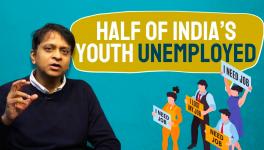The Sword of Mounting Unemployment Hangs Over Modi
Image for representational use only; Image Courtesy : Avenue Mail
Unemployment is death by a thousand cuts. Not only is it the source of endemic poverty which destroys families inch by inch, it is also the fount of social and political unrest. Under the Narendra Modi regime, the unabated rise in the number of jobless people – especially youth – has reached unprecedented proportions. According to latest estimates of the Centre of Monitoring Indian Economy (CMIE), the number of unemployed stood at a staggering 6.9 crore, some 7.4% of the working age population. Most of the unemployed are young people, mostly in rural areas. Joblessness is higher among women.

The CMIE estimates are arrived at through a sample survey of about 1.4 lakh households, with periodic big slice surveys (called Waves) of which the next one will be in February this year. So, there might be some errors in this estimation. But in the absence of regular periodic surveys by the government, and the flood of false or erroneous official ‘data’ on jobs put out, CMIE remains the only valid estimation. The trend shown by this is crystal clear – that unemployment is steadily increasing since July 2017. In fact, it appears to have more than doubled since then.
Under-Employment
What is not covered or recorded in this data is the complementary phenomenon of under-employment, which is far more prevalent than pure joblessness. This is of two types – people working on very low wages or people working irregularly. (Of course, these two can co-exist too).
Nobody can just sit around and starve to death. People would rather take up any job on offer, even if for a pittance. So, we have qualified and educated people working as manual labourers or in low-paying jobs, computer-trained youth working as data entry operators, or MAs and PhDs working as clerks, etc.
Then there are marginal workers who make up about a third of the workforce. They work for anything between a month or two to 6-8 months in a year. Many of them do seasonal agricultural work, supplemented by piecemeal work in the rural job guarantee scheme (Mahatma Gandhi National Rural Employment Guarantee Scheme or MGNREGS). All this is hidden or disguised unemployment.
Falling Work Participation
Another dimension of the jobs crisis is the steadily falling work participation rate, which is the percentage share of working age population (over 15 years age) that is actually working and also those who are willing to work but not finding jobs (unemployed). Those that remain are people unwilling to work – students, women bound to domestic duties, elderly etc.
Strangely, work participation rate is also steadily falling in India. This has declined from about 47.6% in January 2016 to 42.47% in December 2018, according to CMIE data.

What does this mean? This means that a large number of people are discouraged by the lack of jobs, frustrated in their efforts to get a job and hence sit back (maybe temporarily) to wait for some opportunity. This is closely tied up with agricultural seasons. Women form the largest share of such workers because they are the first to lose their jobs in an economy that is slowing down.
But a steadily declining work participation is a dangerous portent. It not only means that people’s lives are getting pushed deeper and deeper into poverty, but also indicates the existence of a large number of people (mostly youth) that are at a loose end. It is such youth that become cannon fodder for all kinds of diversionary and destructive movements, such as cow protection squads and the ‘mandir wahin banaenge’ (temple construction) army.
Political Fallout – Reservation
There is vast discontent across the country on the jobs crisis, especially because Prime Minister Narendra Modi had famously assured the youth during his 2014 election campaign that he would provide one crore jobs every year. This crisis has been reflected in several movements for reservation in government jobs – from Patels and Marathas to Jats and Gujjars, all have been agitating for such reservations. It is immaterial to them that actually government jobs are too few to in any way ameliorate the severe jobs crisis. This restlessness has been reflected in the state Assembly elections where, for example in Gujarat, the Patidars turned against the BJP.
The other side of this coin is that governments try to invoke reservations to assuage the anger at the lack of new jobs. The Maharashtra government announced reservations for Marathas, Haryana and Gujarat announced reservations for poor upper caste members. And, the Modi-led central government itself acknowledged its failure to create jobs by declaring a 10% quota for ‘poor’ people, although the poor were defined rather liberally as those with less than Rs 66,000 income per month, which envelops 95% of population.
But, the biggest fallout of the jobs crisis will probably be visible in the upcoming general elections when Modi and his party, the Bharatiya Janata Party, will be called out for their false promises on the jobs front.
Get the latest reports & analysis with people's perspective on Protests, movements & deep analytical videos, discussions of the current affairs in your Telegram app. Subscribe to NewsClick's Telegram channel & get Real-Time updates on stories, as they get published on our website.
























